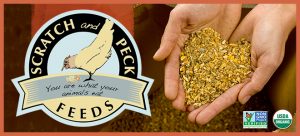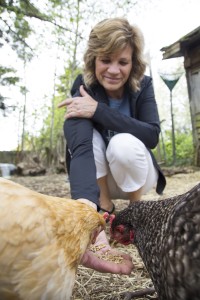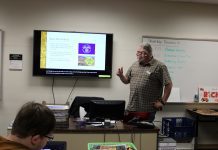
Scratch and Peck Feeds formed from a simple need. The founder, Diana Ambauen-Meade, wasn’t happy with the types of chicken feed available in stores. Every time she fed her chickens a feed that contained less than optimal ingredients, she contemplated the implications they may have on her own health. So she took matters into her own hands. She began making her own feed at home, in her backyard, using a borrowed cement mixer and whole grains sourced from local farmers.
Diana’s efforts soon expanded into a business with a small base of customers who also wanted clean, whole grain feeds — free from medication, pesticides and other toxic chemicals. She soon realized that she was moving into a fully-operating animal feed manufacturing company, and decided that if that was the direction she was going, she might as well go the extra mile and become Non-GMO Project Verified and Certified Organic.

“I knew it would be a lot of work,” Diana said, “but I wanted to do it right and show my commitment to bigger issues in the feed industry that need to be addressed. I couldn’t imagine releasing a product that didn’t live up to my values and commitments to the planet, to human health, and to the welfare of all living things.”
To become Certified Organic and Non-GMO Project Verified requires substantial paperwork, inspections of the mill and obtaining proof of certifications from each of the farmers and suppliers who provide the ingredients. The process doesn’t stop once those certifications are achieved. Every day the folks at Scratch and Peck adhere to strict protocols and precautions to ensure that the ingredients meet all verifications and regulations. Care is taken in all phases of their manufacturing, from receiving and handling to storing and processing. Traceability and accountability of all ingredients is key.
Diana has established partnerships with local and regional farmers and suppliers who are organic and non-GMO. She visits the farms, confirms the certifications and, if everything aligns with the sustainable focus of Scratch and Peck, forms a partnership. For Diana, these partnerships are some of the most rewarding aspects of what Scratch and Peck does.
“Some of my most memorable conversations have been with farmers who are passionate about what they do and proud of the quality crops they grow,” Diana said. “They are critical to producing a trustworthy product.”

Once farmers have harvested the grains, even the transportation process to the mill must show adherence to the regulations of Certified Organic and Non-GMO Project Verified. Truck drivers provide a Clean Truck Affidavit prior to grain pick up to verify that their truck was cleaned between loads to eliminate the risk of cross contaminations with GMO or non-organic ingredients. Even though these extra steps take extra work, the employees have fun.
“The grain truck drivers are like family alongside our mill staff. I’ll frequently hear them out in the mill giving each other a hard time and laughing,” said Scratch and Peck Production Manager, Richy Boyer. “They often help us out to ensure both the ingredients and the end products are handled with concern and care.”
Annual audits and onsite inspections by certification bodies are part of the process, and ongoing testing of all major high-risk ingredients is a tenant of Non-GMO Project verification to ensure that no cross-contamination occurred at any stage. For example, corn is a high-risk crop because more than 90% of the corn produced in the United States is genetically engineered. Customers are often surprised, and pleased, to learn that even the corn in Scratch and Peck’s feed is non-GMO and organic.
“I want to offer a feed that contains corn, because the carbohydrates are a good source of energy to help keep chickens warm during cold months, but it was absolutely necessary that the corn we used didn’t contain GMOs,” Diana explained.

Diana extensively researched farms that grew non-GMO corn and finally found a source that she was confident could supply quality corn that met Non-GMO Project and organic regulations and was grown in the Pacific Northwest.
Scratch and Peck is meticulous in monitoring its daily operations, which remain small scale so that ingredients can be evaluated as they come into the mill and during the mixing process. Every bag of feed is recorded and tracked with a batch number that details the ingredients contained in that particular product. This start-to-finish supervision means that the crew at Scratch and Peck are putting out a product they’re excited about — sometimes too excited. Occasionally a mill employee will put feed in someone else’s coffee cup so there’s an unexpected surprise waiting for them when they go to take their last sip.
Although human-grade and delicious to the last drop, the feed is really meant for animals.
“Save it for the chickens,” said Richy. “They’re really the ones who appreciate a mouthful of feed. Humans, not so much.”








































